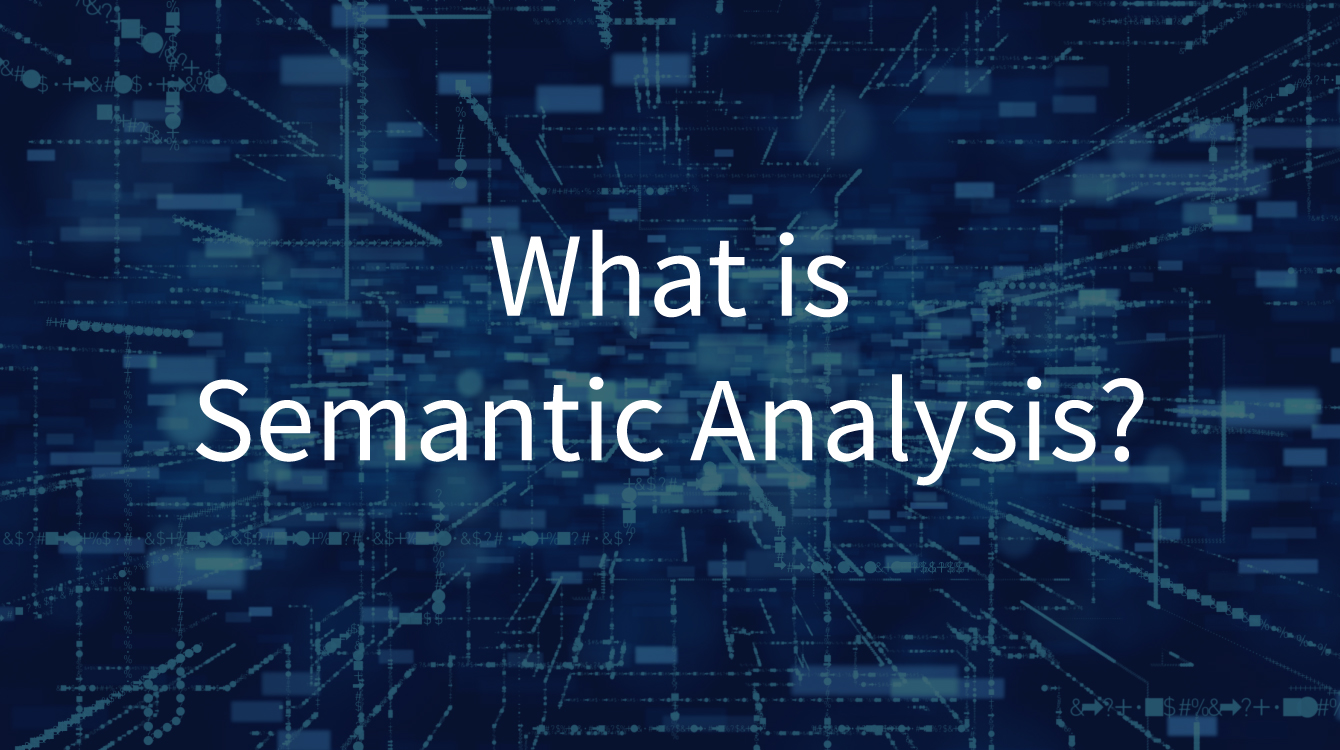
Articles | April 29, 2020 | 6 min read
What Is Semantic Analysis?
This blog is going to answer the questions of ‘what is semantic analysis’ and ‘why semantics is important’ to marketers…but we didn’t have to tell you that, did we?
You knew it already.
How did you know it?
Because of the contextual clues:
You used these two contextual clues to understand the implied meaning behind the title What Is Semantic Analysis? and accurately predict what this blog is going to discuss.
What you just did right there?—That’s semantic analysis (SA).
In fact, we’re so good at it’s generally an unconscious exercise, like breathing…we just do it without thinking about it.
We analyze…
…and then use the output of that analysis to predict an outcome with incredible accuracy.
For the bulk of recorded history, semantic analysis was the exclusive competence of man—tools, technologies, and machines couldn’t do what we do. They couldn’t process context to understand what material is relevant to predicting an outcome and why.
But the evolution of Artificial Intelligence, machine learning, and natural language processing has changed all that. Advancing algorithms, increasingly powerful computers, and data-based practice have made machine-driven semantic analysis a real thing with a number of real world applications.
Machine-driven semantic analysis can…
And so much more!
And it wasn’t good.
In the early days of MarTech, people wrote programs to scrape huge amounts of data for recurring words and phrases (remember word clouds?).
Why? Because there was a belief that word frequency was tied to importance—the more important the word, the more frequently it will appear. Yet this belief made many erroneous assumptions, chief among them being that “context doesn’t matter.”
But as anyone who’s ever been on a date, gone to a comedy show, or had the most basic of human interactions can tell you, “context matters a helluva lot.” Without the surrounding context, the frequency of a word is pretty meaningless.
Want to see what we mean?
A textual analysis for the word “whip” might capture a result like this…

…which is great because we were thinking of the word “whip” in the context of a “bullwhip.”
However, a textual analysis for the word “whip” might just as easily capture a result like this…

Or this…

Or this…
Annnnnd that would be a problem, wouldn’t it?
Tagging attempted to use human understanding of content to create keyword-based guidelines machines could follow to identify important content (content relevant to an individual searcher’s underlying need). But like textual analysis, tagging came with a laundry list of limitations—redundant tags, misspelled tags, inconsistently applied tags, over-tagging, etc. Ultimately, tagging proved to be no better than an educated guess of end-user intention.
(To be clear, this isn’t to say marketers should stop tagging their content—tags are an important component of semantic understanding. Rather, it is to say you must use tags in accordance with an authoritative, data-driven taxonomy or a defined set of rules.)
As social media and user-generated content started taking over the internet in the early 2000s, marketers began developing an insatiable appetite for meaning in data—not just knowing whether individual consumers were talking about a given brand, but how those consumers felt towards the brand, its products, and its services.
To feed marketers demand for sentiment, social analytics platforms began offering “hot or cold” analyses of topics and brands.
But what is sentiment analysis? In truth, it’s nothing more than an application of explicit understanding (e.g. if the word “sucks” appears in a Tweet alongside “Nike”, and the social analytics platform knows to identify the word “sucks” as an indicator of negativity, then the platform can infer that what’s being said by the consumer about the Nike brand is negative).
From a data processing point of view, semantics are “tokens” that provide context to language—clues to the meaning of words and those words’ relationships with other words. From these “tokens” the expectation is for the machine to look beyond the individual words used to identify the true meaning of what’s being said as a whole.
Successful semantic analysis requires a machine to look at MASSIVE data sets, and in analyzing those sets form accurate assumptions that account for context. Put another way, it’s about asking a machine to make meaningful cognitive leaps using data-based measures (frequency, location, etc.).
(For example, having a computer make the connection that a “Dalmatian” is a “spotted breed of dog” from semantic information provided through large data sets.)

Why do we care if a computer knows that a Dalmatian is a spotted breed of dog? Because if it knows a Dalmatian is a spotted breed of dog, it will know that someone searching for “spotted dog,” is really looking for content related to Dalmatians.
In order to make sure content is relevant to the user, two components are required:
The problem with establishing relationships between pieces of content is that most “scraping” or “data-capture” technology doesn’t understand the contextual language within a document very well. There may be simplistic levels of machine learning involved, but those levels rely heavily on provided tags and a cursory understanding of the individual words on the page…leaving the door wide open for improvement.
“If we can understand the content and the user behavior at a deep, semantic level, we can deliver more relevant content and thereby create a more resonant user experience.”
If you search for the term “jaguar,” you will return results for:
A predator...

A luxury car…

A football team…

And a number of other results that would likely surprise you.
Therefore, how semantic analysis works is by pairing the term “jaguar” to your true intention in order to deliver the content you’re looking for. To achieve this goal, a machine will:
The number of connections a machine can make (and how well that machine can understand the relationships between those connections) will determine the relevance of the results delivered to the searcher (in this case, you).
Relevance is both the goal and the unit of measure when it comes to semantic analysis—understanding both the content and the individual’s intention (or need) is the key to delivering a more valuable and resonant user experience.
With that, we hope you now know how to answer the question What Is Semantic Analysis?, and that you have a better understanding of the role it plays in delivering an exceptional user experience. If you want to learn more about delivering a superior user experience, check out our whitepaper on the importance of website personalization.
You knew it already.
How did you know it?
Because of the contextual clues:
- The title (it literally says “what is semantic analysis”)
- The publication (you know Zeta blog publishes content targeted at marketers)
You used these two contextual clues to understand the implied meaning behind the title What Is Semantic Analysis? and accurately predict what this blog is going to discuss.
What you just did right there?—That’s semantic analysis (SA).
Humans do semantic analysis incredibly well.
In fact, we’re so good at it’s generally an unconscious exercise, like breathing…we just do it without thinking about it.
We analyze…
- Context surrounding words, phrases, objects, scenarios, etc.
- Pull out the relevant information
- Compare that information against prior experience (or a taxonomy in the case of machines)
…and then use the output of that analysis to predict an outcome with incredible accuracy.
Machines couldn’t do what we do
For the bulk of recorded history, semantic analysis was the exclusive competence of man—tools, technologies, and machines couldn’t do what we do. They couldn’t process context to understand what material is relevant to predicting an outcome and why.
But the evolution of Artificial Intelligence, machine learning, and natural language processing has changed all that. Advancing algorithms, increasingly powerful computers, and data-based practice have made machine-driven semantic analysis a real thing with a number of real world applications.
Machine-driven semantic analysis can…
- Discover the meaning of colloquial speech in online posts
- Find an answer to a question without having to ask a human
- Extract relevant and useful information from large bodies of unstructured data
And so much more!
Before semantic analysis, there was textual analysis
And it wasn’t good.
In the early days of MarTech, people wrote programs to scrape huge amounts of data for recurring words and phrases (remember word clouds?).
Why? Because there was a belief that word frequency was tied to importance—the more important the word, the more frequently it will appear. Yet this belief made many erroneous assumptions, chief among them being that “context doesn’t matter.”
But as anyone who’s ever been on a date, gone to a comedy show, or had the most basic of human interactions can tell you, “context matters a helluva lot.” Without the surrounding context, the frequency of a word is pretty meaningless.
Want to see what we mean?
A textual analysis for the word “whip” might capture a result like this…

…which is great because we were thinking of the word “whip” in the context of a “bullwhip.”
However, a textual analysis for the word “whip” might just as easily capture a result like this…

Or this…

Or this…
Annnnnd that would be a problem, wouldn’t it?
Then there was tagging…
Tagging attempted to use human understanding of content to create keyword-based guidelines machines could follow to identify important content (content relevant to an individual searcher’s underlying need). But like textual analysis, tagging came with a laundry list of limitations—redundant tags, misspelled tags, inconsistently applied tags, over-tagging, etc. Ultimately, tagging proved to be no better than an educated guess of end-user intention.
(To be clear, this isn’t to say marketers should stop tagging their content—tags are an important component of semantic understanding. Rather, it is to say you must use tags in accordance with an authoritative, data-driven taxonomy or a defined set of rules.)
Sentiment analysis makes a brief splash
As social media and user-generated content started taking over the internet in the early 2000s, marketers began developing an insatiable appetite for meaning in data—not just knowing whether individual consumers were talking about a given brand, but how those consumers felt towards the brand, its products, and its services.
To feed marketers demand for sentiment, social analytics platforms began offering “hot or cold” analyses of topics and brands.
But what is sentiment analysis? In truth, it’s nothing more than an application of explicit understanding (e.g. if the word “sucks” appears in a Tweet alongside “Nike”, and the social analytics platform knows to identify the word “sucks” as an indicator of negativity, then the platform can infer that what’s being said by the consumer about the Nike brand is negative).
“What is semantic analysis? It’s not about teaching the machines, it’s about getting them to learn.”
From a data processing point of view, semantics are “tokens” that provide context to language—clues to the meaning of words and those words’ relationships with other words. From these “tokens” the expectation is for the machine to look beyond the individual words used to identify the true meaning of what’s being said as a whole.
Successful semantic analysis requires a machine to look at MASSIVE data sets, and in analyzing those sets form accurate assumptions that account for context. Put another way, it’s about asking a machine to make meaningful cognitive leaps using data-based measures (frequency, location, etc.).
(For example, having a computer make the connection that a “Dalmatian” is a “spotted breed of dog” from semantic information provided through large data sets.)

Why is Semantic Analysis so important to deliver relevant content?
Why do we care if a computer knows that a Dalmatian is a spotted breed of dog? Because if it knows a Dalmatian is a spotted breed of dog, it will know that someone searching for “spotted dog,” is really looking for content related to Dalmatians.
In order to make sure content is relevant to the user, two components are required:
- An understanding of the user
- An understanding of the content
The problem with establishing relationships between pieces of content is that most “scraping” or “data-capture” technology doesn’t understand the contextual language within a document very well. There may be simplistic levels of machine learning involved, but those levels rely heavily on provided tags and a cursory understanding of the individual words on the page…leaving the door wide open for improvement.
“If we can understand the content and the user behavior at a deep, semantic level, we can deliver more relevant content and thereby create a more resonant user experience.”
What happens when you search for the term “jaguar”?
If you search for the term “jaguar,” you will return results for:
A predator...

A luxury car…

A football team…

And a number of other results that would likely surprise you.
Therefore, how semantic analysis works is by pairing the term “jaguar” to your true intention in order to deliver the content you’re looking for. To achieve this goal, a machine will:
- Find contextual clues in your online behavior, past or present (have you been researching “new cars”? Did you recently search for “zoos nearby”?).
- Look at all the content at its disposal where “jaguar” (or related words) occur to determine what content will best match the intentions behind your search.
The number of connections a machine can make (and how well that machine can understand the relationships between those connections) will determine the relevance of the results delivered to the searcher (in this case, you).
Relevance is both the goal and the unit of measure when it comes to semantic analysis—understanding both the content and the individual’s intention (or need) is the key to delivering a more valuable and resonant user experience.
With that, we hope you now know how to answer the question What Is Semantic Analysis?, and that you have a better understanding of the role it plays in delivering an exceptional user experience. If you want to learn more about delivering a superior user experience, check out our whitepaper on the importance of website personalization.


